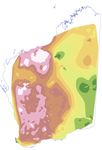Samarium-neodymium isotope map of Western Australia
←
→
Page content transcription
If your browser does not render page correctly, please read the page content below
ACCELERATED GEOSCIENCE PROGRAM
Samarium–neodymium isotope map of
Western Australia
by
Y Lu, MTD Wingate, DC Champion1, RH Smithies, SP Johnson, DR Mole2,
M Poujol3, J Zhao4, R Maas5 and RA Creaser6
Abstract
Isotope maps are used to characterize lithospheric architecture through time, to understand crustal
evolution and mineral system distributions, and play an increasingly important role in exploration
targeting.
These Sm–Nd isotope maps of Western Australia (Fig. 1) are based on whole-rock Sm–Nd data
for felsic igneous rocks, which provide a window into the middle and lower continental crust, and
are used for isotope mapping. Although mafic to intermediate igneous and sedimentary rocks were
not used in constructing the contoured isotope maps, Sm–Nd data for those samples are included
with those for felsic igneous rocks in the data table.
The maps show two-stage depleted mantle model ages (TDM2, proxy for the age of the crustal
source of the igneous rocks) and crustal residence time (the difference between TDM2 and magmatic
crystallization age, i.e. the length of time the source of the igneous rocks has resided in the crust).
The model age gradients are typically associated with major crustal structures and are potentially
important for localizing mineral systems. Map colours in areas with no sample reflect interpolated
values and may have little or no relationship with underlying crust.
The data layer is best accessed using GeoVIEW.WA. This online interactive mapping system
allows data to be viewed and searched together with other datasets, including Geological Survey
of Western Australia (GSWA) and Geoscience Australia (GA) geochronology data, geological maps
and mineral exploration datasets. Data for individual sample points can be viewed by selecting the
symbols. The Sm–Nd isotope map data layer is also available for download from the Data and
Software Centre, as ESRI Shape files and MapInfo Tab files. These datasets are subject to ongoing
updates as new data are generated and compiled.
The isotope maps were created using the Natural Neighbor interpolation tool in ArcGIS Spatial
Analyst. The isotope maps are presented as both stretched (Histogram Equalize type, Fig. 1a,c)
and classified (natural breaks classification, Fig. 1b,d) raster datasets. Some isotope gradients may
not be as pronounced in the statewide map as they might be on more detailed maps of individual
regions. It is therefore recommended that users download the isotope data and create their own
contour maps for particular areas, to enhance the isotope gradients in those areas.
The Sm–Nd isotope samples and associated data were compiled as part of a collaboration
between GSWA and GA. Acquisition of GSWA’s Sm–Nd isotope data involved collaboration with
several university research laboratories and was funded by the Exploration Incentive Scheme.
1 Geoscience Australia, GPO Box 378, Canberra, ACT 2601, Australia
2 Mineral Exploration Research Centre, Harquail School of Earth Sciences, Laurentian University, Sudbury, ON P3E 2C6, Canada
3 GeOHeLiS, Géosciences Rennes, UMR 6118, Université Rennes 1, 35042 Rennes cedex, France
4 Radiogenic Isotope Facility, School of Earth Sciences, University of Queensland, Brisbane, QLD 4072, Australia
5 School of Earth Sciences, University of Melbourne, Parkville, VIC 3010, Australia
6 Department of Earth and Atmospheric Sciences, University of Alberta, Edmonton, AB T6G 2E3, Canada
1ACCELERATED GEOSCIENCE PROGRAM
a) Two-stage depleted Crystallization age (Ma) b) Two-stage depleted
mantle model age, mantle model age,
TDM2 (Ma) TDM2 (Ma)
1300, low 540–1000 1300
1000–1600 1920
1600–2500 2070
2500–2800 2240
2800–3200 2410
3200–3600 2600
3600–4000 2800
3000
3160
3350
4000, high 4000
c) Crustal residence time, d) Crustal residence time,
TCR (Ma) TCR (Ma)
0 or less, lowACCELERATED GEOSCIENCE PROGRAM
Recommended reference
Lu, Y, Wingate, MTD, Champion, DC, Smithies, RH, Johnson, SP, Mole, DR, Poujol, M, Zhao, J, Maas, R and
Creaser RA 2021, Samarium–neodymium isotope map of Western Australia: Geological Survey of Western
Australia, digital data layer.
Disclaimer
This product uses information from various sources. The Department of Mines, Industry Regulation and Safety (DMIRS)
and the State cannot guarantee the accuracy, currency or completeness of the information. Neither the department nor
the State of Western Australia nor any employee or agent of the department shall be responsible or liable for any loss,
damage or injury arising from the use of or reliance on any information, data or advice (including incomplete, out of date,
incorrect, inaccurate or misleading information, data or advice) expressed or implied in, or coming from, this publication or
incorporated into it by reference, by any person whosoever.
© State of Western Australia (Department of Mines, Industry Regulation and Safety) 2021
With the exception of the Western Australian Coat of Arms and other logos, and where otherwise noted, these data are provided under
a Creative Commons Attribution 4.0 International Licence. (http://creativecommons.org/licenses/by/4.0/legalcode)
3You can also read





















































